I have been trading cryptocurrencies for 10 years and have earned nearly 1.1 million. To change my fate, I must try cryptocurrency trading. If you can't make money in this circle, ordinary people will have no chance in their lifetime. Recently, I had the privilege to drink tea with a big shot in the cryptocurrency world and discuss the trends of the cryptocurrency market.
His words deeply shocked me.
It turns out that he once blew up his account due to contract trading within three days, losing as much as 50 million. This experience was undoubtedly a profound lesson for him.
Looking back at my own journey in the cryptocurrency world, it has also been tumultuous. From initially entering the market with 50,000 to profiting tens of millions in a bull market; then from tens of millions back to over 2,000; now, I am waiting for the next bull market to come, aiming to reach 2 million.
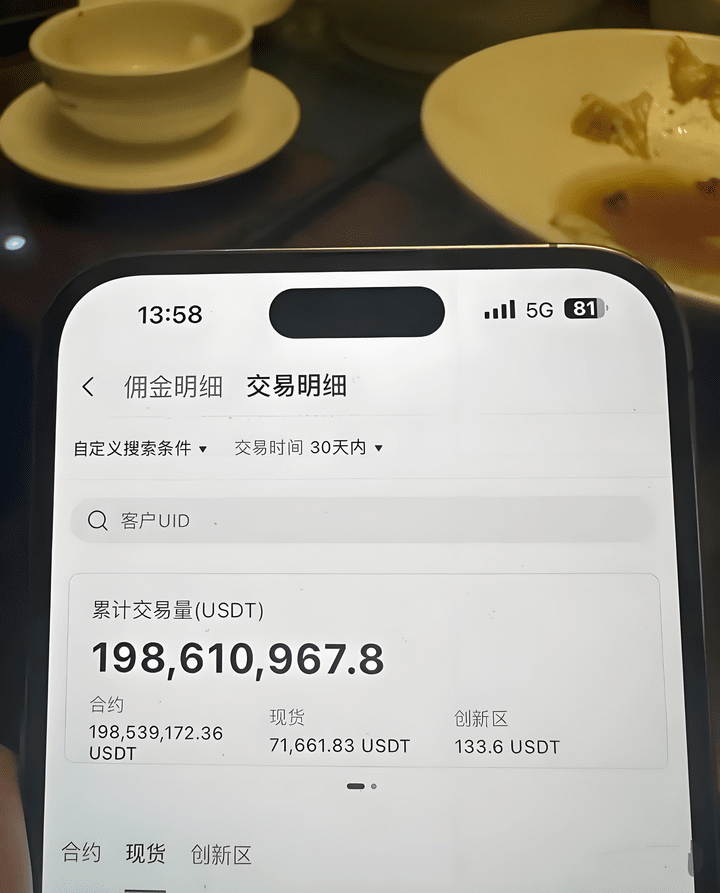
In a chaotic market, many people always try to see everything clearly, but the longer you survive in the market, the more you realize that the market itself is disordered. 'Simplicity is the ultimate sophistication' may be the most effective principle when facing the market.
Trading 'heart sutra'
Investment is a systematic management task. The stock market serves as one direction of investment, balancing capital management structure and diversifying investment targets, which is very important for both institutions and individuals, but many people fail to realize this.
My understanding of trading concepts and the stock market is constantly evolving, and this change is also an external manifestation of self-improvement.
Trading 'external skills'
In trend trading, I will refer to support/resistance levels while considering some macro factors.
I have no special requirements for the selection of individual stock varieties, and the individual stock varieties I generally pay attention to will not exceed 5.
At the same time, I will adopt a gradual position-building method, starting with about 10% of the capital proportion, and the stop-loss ratio will vary depending on the entry cycle, but I will be quite strict in controlling the overall position drawdown.
Regarding trading mentality, I believe the most important thing is to stay true to oneself.
So how to trade cryptocurrencies well? Once a person enters the financial market, it is difficult to turn back. If you are currently losing yet still confused, and plan to treat cryptocurrency trading as a second career, you must know the 'MACD advanced strategy.' Understanding it deeply can save you from many detours; these are personal experiences and feelings, and I suggest you save and reflect on them repeatedly!
Without further ado, let's get straight to the point! I will teach you step by step how to use MACD to find the best buy and sell points!
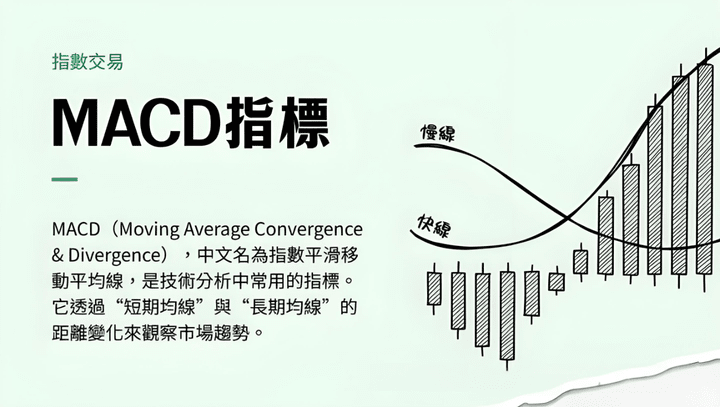
The MACD indicator is a relatively common technical indicator. The more common the technical analysis, the more people reference it, making it worth our time to become familiar with. However, most people do not understand how to accurately apply the MACD indicator.
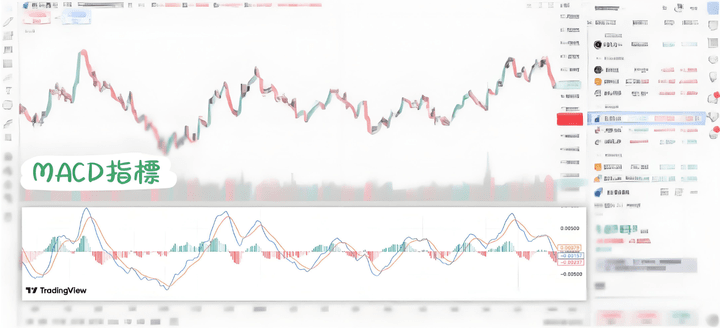
Through this article, we will start from scratch to understand this most familiar technical indicator, learn how to use the MACD indicator to find appropriate buy and sell points as well as trend reversal points, thereby discovering more quality trading opportunities.
What is the MACD indicator?
The MACD indicator, also known as the Exponential Moving Average Convergence Divergence (MACD), is based on the moving average line. The MACD analyzes the relationship between 'short-term' and 'long-term' moving averages to observe changes in market trends, thereby knowing what trend the market is currently in, where there are trading signals, and discovering market reversal points early.
Beginners who want to understand the MACD indicator in more detail need to have a basic understanding of moving averages. This is because MACD evolves from two moving average lines.
How to read the MACD indicator?
The MACD indicator consists of four parts, including the DIF line, DEA line, MACD histogram, and zero line. Each part represents different data, all obtained from the original chart, just to present them in a more in-depth yet intuitive way, which is why the MACD indicator was born.
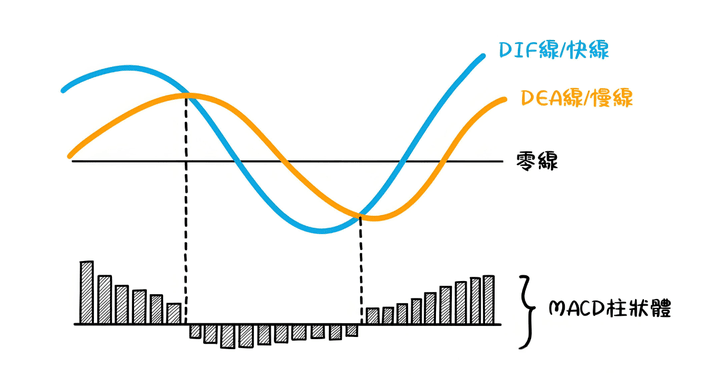
Here are some introductions to these four parts:
DIF line, fast line
DEA line, slow line
MACD histogram
Zero line
1. MACD line (DIF line/fast line)
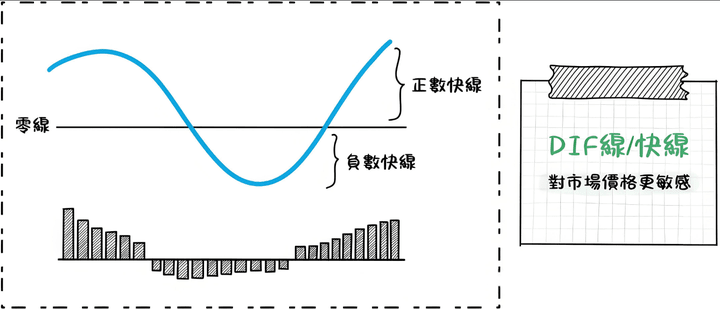
The MACD line is also called the DIF line (Differential Line); it is the difference between the short-period average line (16 EMA) and the long-period average line (26 EMA). The MACD line exists to analyze short-term price changes. The MACD line or DIF line can be positive or negative.
MACD fast line = short-period average line - long-period average line
Positive MACD line:
Indicates that the short-period average line value is greater than the long-period average line value, meaning that the product's short-term average price is higher than the long-term average price, indicating that the financial product is in an upward trend.
Negative MACD line:
Indicates that the short-term average line value is less than the long-term average line value, i.e., the short-term average price is lower than the long-term average price, indicating that the market financial product is in a downward trend.
The MACD line is also called the fast line because it is most sensitive to changes in market prices.
2. Signal line (DEA line/slow line)

In simple terms, the signal line (slow line) is the average value of the MACD line over a past period (usually 9 days). Since it is based on past MACD data for analysis, it is also known as the slow line. The purpose of the signal line is to capture longer-term trends.
Signal line/slow line = ∑(n MACD fast line) / n
n = the time period we want to select
The appearance of the slow line is to help us as traders to discover trading opportunities more quickly.
3. MACD histogram

The MACD histogram was created to understand the difference between the DIF line and the DEA line. With the histogram, we can see the difference more clearly.
MACD histogram = DIF line - DEA line
The histogram is also divided into positive and negative values. From these histograms, we can know:
Histogram is positive:
The fast line (DIF line) is above the slow line (DEA line)
Histogram is 0:
The fast line (DIF line) and the slow line (DEA line) are flat; this is a convergence point.
Histogram is negative:
The fast line (DIF line) is below the slow line (DEA line)
4. Zero line
The zero line serves as a reference level, distinguishing the fast line and slow line between positive and negative values, acting as a boundary line that allows us to clearly see which area the current MACD data is in.
How to use the MACD indicator
The MACD indicator has many uses, and the three most common usage methods are to find the following information through MACD:
1. How to use the MACD indicator to observe price trends?
The simplest way to use the MACD indicator is to observe trends in financial product trading, with the most common applications including foreign exchange trading and stock trading. Trends in trading can be divided into two types: upward trends and downward trends.
Uptrend: When both the fast line and the slow line are above the zero line, the product is generally in an uptrend.
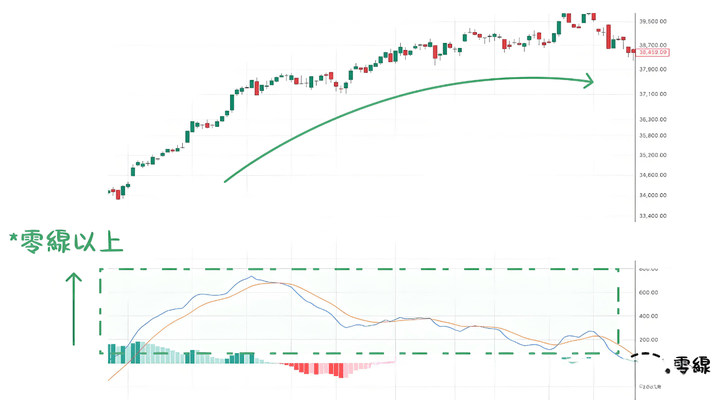
Downtrend: When both the fast line and the slow line are below the zero line, the product is generally in a downtrend.
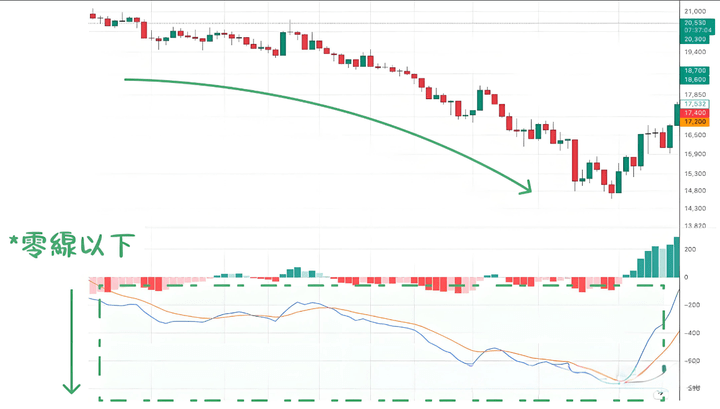
MACD is not only very suitable for traditional stock trading but can also be integrated into short-term trading of other financial products, one of the most popular being high-leverage foreign exchange trading.
Through leveraged foreign exchange trading, we can operate larger amounts with a small amount of margin, but it also brings risks. Using the MACD indicator can enhance accuracy, reduce risks, and help you operate steadily in a volatile market.
2. How to use MACD golden cross and death cross to find buy and sell points?
Using the MACD indicator to find buy and sell points is the most common analysis method. By identifying golden crosses or death crosses, we can find the points to go long or short. The following image demonstrates using EUR/USD as an example:
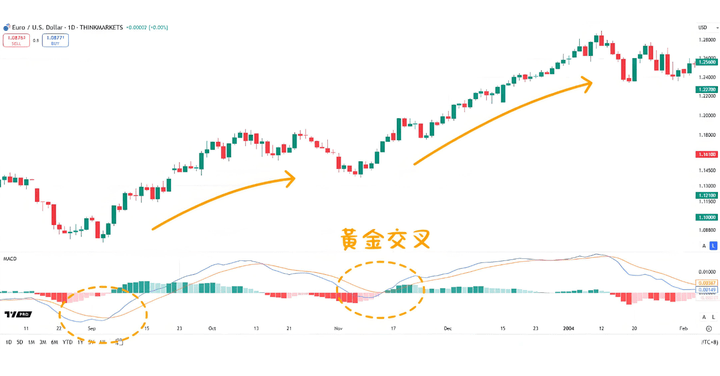
When the fast line (blue line) breaks through the slow line (orange line) from below, it is called a golden cross, which is a good reference for a buy or long signal.
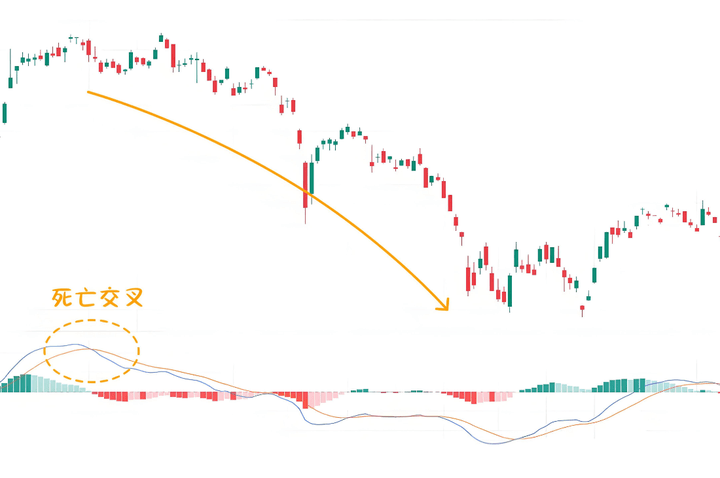
When the fast line (blue line) breaks down through the slow line (orange line) from above, it is called a death cross, which is a good reference for a sell or short signal.
MACD golden cross
MACD death cross
3. How to find trend reversal points through MACD divergence?
This is an advanced way to use the MACD indicator. When the price trend and the MACD indicator show inconsistent trends, there is a chance of MACD divergence. Simply put, investors' emotions and views on price trends have changed, and they believe that the price of the financial product does not match its actual value.
The occurrence of MACD divergence is a warning, which can be divided into two types, providing investors with a potential buy or sell signal:
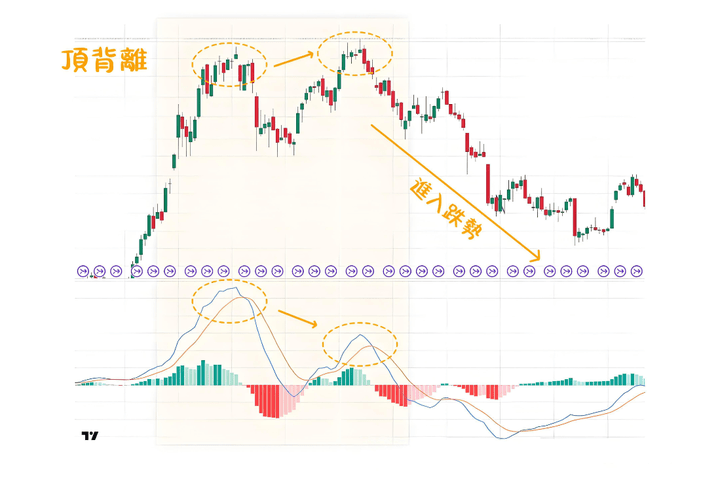
When the price forms a series of higher peaks, but the MACD line forms a series of lower peaks, a top divergence is formed. This indicates that the upward momentum of the price is weakening, and the market actually holds a skeptical attitude towards the subsequent price increase, so the death cross that appears after the top divergence can also be seen as a sell/short signal.
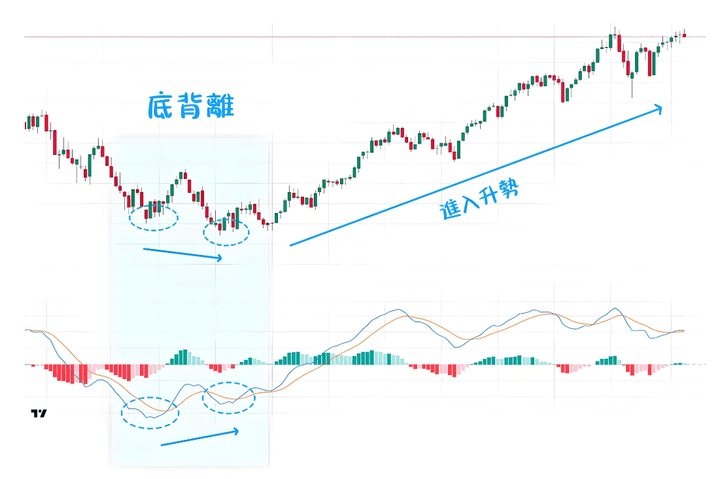
When the price forms a series of lower peaks, but the MACD line forms a series of higher peaks, a bottom divergence is formed. This indicates that the trend of price decline has slowed, and the market believes that the subsequent decline may be a good opportunity to buy back, thus a golden cross after the bottom divergence is considered a buy/long signal.
Top divergence (high divergence)
Bottom divergence (support divergence)
Adjustment of MACD indicator parameters
Adjusting MACD parameters is an advanced way to use MACD. By fine-tuning the MACD parameters, we can increase the adaptability of MACD to specific financial products.
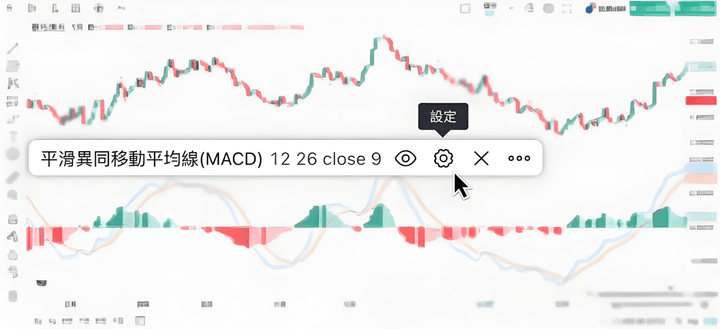
If you want to adjust the parameters, you can click on MACD settings to open the settings window and start adjusting the parameters.
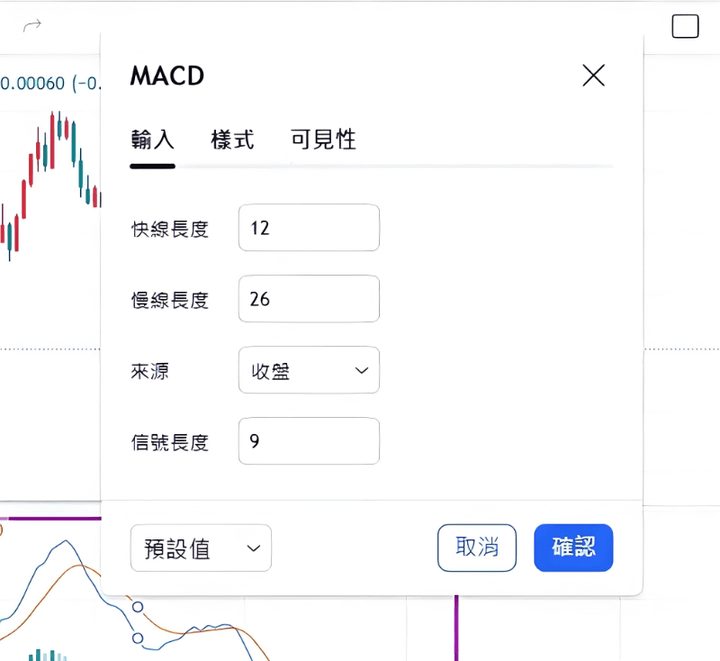
The default parameters for the MACD indicator in all charting software are 12, 26, and 9, which are considered the best parameters for MACD, representing:
Fast line length: The period of the short-term EMA average line (usually the short-term reference average line for the DIF line is the moving average price of the past 12 K lines)
Slow line length: The period of the long-term EMA average line (usually the long-term reference average line for the DIF line is the moving average price of the past 26 K lines)
Signal length: The length of the MACD signal line (usually the signal line is the moving average of the MACD line values of the past 9 K lines)
However, MACD parameter settings can also be optimized based on the nature of different financial products and the needs of traders themselves.
In a more volatile market, consider using a shorter time frame.
In a less volatile market, a longer time frame can be used.
Combining MACD indicator with other indicators
Since MACD is a lagging indicator, most traders will combine MACD with other indicators or support and resistance lines for use. One of the most common and easiest methods is to use MACD with support and resistance lines.
Next, I will take you step by step on how to use support and resistance lines in conjunction with the MACD indicator:
Step 1: Identify chart resistance and support.
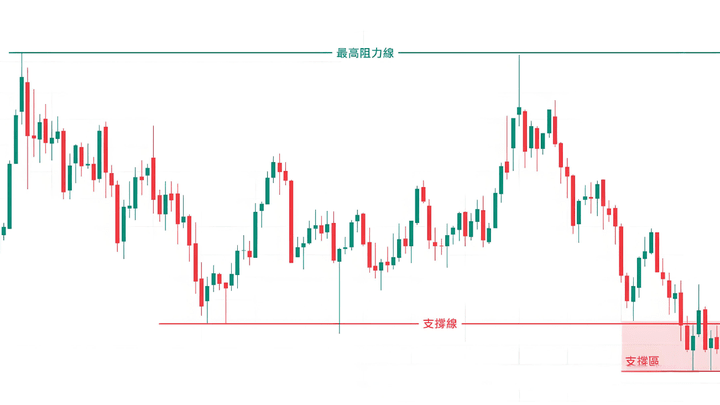
In the charts we choose, identify resistance and support lines to give us a concept of where price may encounter resistance pullbacks or support rebounds.
Step 2: Import and observe the MACD indicator to identify entry points.
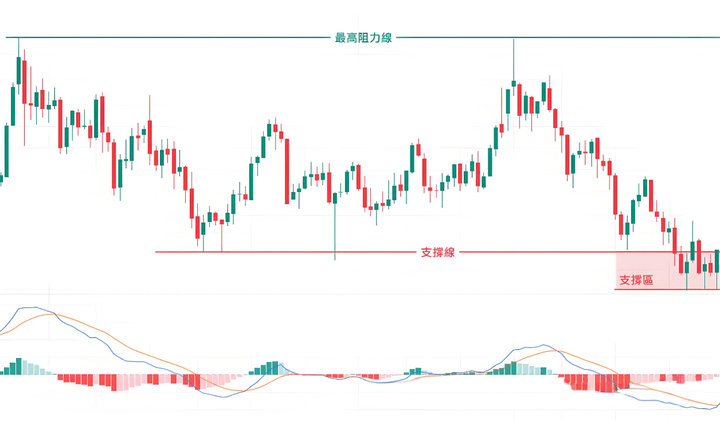
If we are bullish, we can wait for the golden cross to appear in the support line area. Once the golden cross appears, we can enter a long trade. After going long, set the stop-loss point below the support line.
Step 3: Decide on the selling point and stop-loss point.
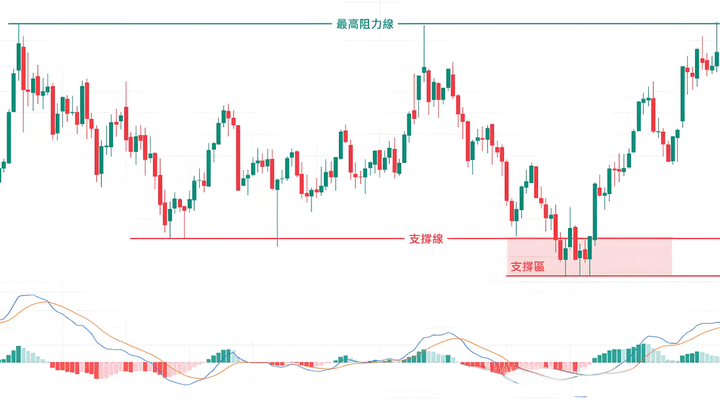
After buying, patiently wait as long as the fundamentals remain unchanged. Only close the position when the price hits the resistance line. If you want to wait until after the death cross to close the position, you may miss out on some profits due to lag.
If you are also a tech enthusiast, please see the picture below:

Written at the end
MACD is a highly valuable technical indicator for learning. Based on the above, a single MACD indicator can be used to design various trading strategies. Even if it is not used as the main indicator, it can be turned into an auxiliary analysis tool. By learning about MACD, we can more easily cultivate our logical thinking and better master how to design and optimize strategies.
The myth of getting rich quickly may be distant, but those who control the pace can steadily pocket the profits. If you have ever felt lost, anxious, and scarred in the market, you might as well try this rhythm.
Calm down and see clearly.
Stop when you need to, move when you need to.
Don't rush, take it slow.
Your path to doubling your investment may truly begin from the moment you take control of the rhythm.
In the cryptocurrency world, it is like a marathon; running fast is not as good as running steadily. Those who earn money by luck often lose it back through strength. Only by embedding position management into one's DNA can one survive in this ruthless market. Remember: to survive is to have a chance to turn things around.
The above are trading insights from 10 years of cryptocurrency trading experience, having gone through many ups and downs. These are heartfelt words of enlightenment, hoping to be useful to everyone. The banquet produced by Yan'an must be a fine product, and there are beauties in the cryptocurrency world, absolutely unique. The spirit has a way, and the technique of managing currency has its own skills!
No matter how diligent a fisherman is, he will not go out to sea to catch fish during a storm; rather, he will take good care of his fishing boat. This season will pass, and sunny days will come! Follow me, and I will teach you both how to fish and how to fish; the door to the cryptocurrency world is always open. To go with the trend is to have a life in accordance with the trend; save this and remember it!
